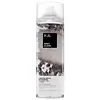What's inside
What's inside
 Key Ingredients
Key Ingredients

 Benefits
Benefits

 Concerns
Concerns

 Ingredients Side-by-side
Ingredients Side-by-side

Isobutane
Propane
Dimethylimidazolidinone Rice Starch
AbsorbentAlcohol Denat.
AntimicrobialAluminum Starch Octenylsuccinate
AbsorbentAmp-Isostearoyl Hydrolyzed Wheat Protein
CleansingRhodiola Rosea Root Extract
EmollientCitrus Junos Seed Extract
AntioxidantCyperus Esculentus Root Oil
MaskingPrunus Insititia Seed Oil
EmollientPanthenol
Skin ConditioningEthylhexyl Methoxycinnamate
UV AbsorberIsopropyl Myristate
EmollientParfum
MaskingCyclopentasiloxane
EmollientAcrylates Copolymer
Water
Skin ConditioningMagnesium Carbonate
AbsorbentVp/Va Copolymer
Triethoxycaprylylsilane
Butylene Glycol
HumectantTalc
AbrasivePentylene Glycol
Skin ConditioningBHT
AntioxidantLinalool
PerfumingAlpha-Isomethyl Ionone
PerfumingEugenol
PerfumingCI 77491
Cosmetic ColorantIsobutane, Propane, Dimethylimidazolidinone Rice Starch, Alcohol Denat., Aluminum Starch Octenylsuccinate, Amp-Isostearoyl Hydrolyzed Wheat Protein, Rhodiola Rosea Root Extract, Citrus Junos Seed Extract, Cyperus Esculentus Root Oil, Prunus Insititia Seed Oil, Panthenol, Ethylhexyl Methoxycinnamate, Isopropyl Myristate, Parfum, Cyclopentasiloxane, Acrylates Copolymer, Water, Magnesium Carbonate, Vp/Va Copolymer, Triethoxycaprylylsilane, Butylene Glycol, Talc, Pentylene Glycol, BHT, Linalool, Alpha-Isomethyl Ionone, Eugenol, CI 77491
Butane
Propane
Sd Alcohol 40-B
AstringentAluminum Starch Octenylsuccinate
AbsorbentOryza Sativa Starch
AbsorbentZeolite
AbsorbentAcrylates Copolymer
Hydrated Silica
AbrasiveCharcoal Powder
AbrasiveSodium Bicarbonate
AbrasiveMagnesium Carbonate
AbsorbentDiisopropyl Adipate
EmollientCellulose
AbsorbentHydroxyethylcellulose
Emulsion StabilisingCamellia Sinensis Leaf Extract
AntimicrobialDisteardimonium Hectorite
StabilisingButylene Glycol
HumectantPolyquaternium-59
UV AbsorberCetrimonium Chloride
AntimicrobialSodium Acetate
BufferingWater
Skin ConditioningPhenoxyethanol
PreservativeParfum
MaskingButane, Propane, Sd Alcohol 40-B, Aluminum Starch Octenylsuccinate, Oryza Sativa Starch, Zeolite, Acrylates Copolymer, Hydrated Silica, Charcoal Powder, Sodium Bicarbonate, Magnesium Carbonate, Diisopropyl Adipate, Cellulose, Hydroxyethylcellulose, Camellia Sinensis Leaf Extract, Disteardimonium Hectorite, Butylene Glycol, Polyquaternium-59, Cetrimonium Chloride, Sodium Acetate, Water, Phenoxyethanol, Parfum
 Reviews
Reviews

Ingredients Explained
These ingredients are found in both products.
Ingredients higher up in an ingredient list are typically present in a larger amount.
Acrylates Copolymer is used as a film-forming agent and texture enhancer.
After applied, Acrylates Copolymer forms a thin film cover that helps skin feel more soft. It can help sunscreens become more water-resistant.
It is also used to make a product more thick.
Learn more about Acrylates CopolymerAluminum Starch Octenylsuccinate is a synthetic powder used as an absorbent, thickener, and anti-caking agent.
As an absorbent, it is great at mattifying skin by soaking up the oil. This is why you'll find it in a range of products from makeup to moisturizers.
This ingredient is considered a modified starch. Starch can also be found naturally in plants.
One study from 1991 found that 5% of this ingredient enhanced titanium dioxide SPF by as much as 40%. The study found 1% titanium dioxide had a 5.6 SPF and adding 5% of aluminum starch octenylsuccinate boosted it to an SPF of 8.1
Although “aluminum” in an ingredient name can raise red flags for some consumers, the form and usage context matter significantly. For typical topical applications, there is no substantial evidence of health risks - such as cancer, neurotoxicity, or systemic “aluminum overload.”
Learn more about Aluminum Starch OctenylsuccinateButylene Glycol (or BG) is used within cosmetic products for a few different reasons:
Overall, Butylene Glycol is a safe and well-rounded ingredient that works well with other ingredients.
Though this ingredient works well with most skin types, some people with sensitive skin may experience a reaction such as allergic rashes, closed comedones, or itchiness.
Learn more about Butylene GlycolWe don't have a description for Magnesium Carbonate yet.
Parfum is a catch-all term for an ingredient or more that is used to give a scent to products.
Also called "fragrance", this ingredient can be a blend of hundreds of chemicals or plant oils. This means every product with "fragrance" or "parfum" in the ingredients list is a different mixture.
For instance, Habanolide is a proprietary trade name for a specific aroma chemical. When used as a fragrance ingredient in cosmetics, most aroma chemicals fall under the broad labeling category of “FRAGRANCE” or “PARFUM” according to EU and US regulations.
The term 'parfum' or 'fragrance' is not regulated in many countries. In many cases, it is up to the brand to define this term.
For instance, many brands choose to label themselves as "fragrance-free" because they are not using synthetic fragrances. However, their products may still contain ingredients such as essential oils that are considered a fragrance by INCI standards.
One example is Calendula flower extract. Calendula is an essential oil that still imparts a scent or 'fragrance'.
Depending on the blend, the ingredients in the mixture can cause allergies and sensitivities on the skin. Some ingredients that are known EU allergens include linalool and citronellol.
Parfum can also be used to mask or cover an unpleasant scent.
The bottom line is: not all fragrances/parfum/ingredients are created equally. If you are worried about fragrances, we recommend taking a closer look at an ingredient. And of course, we always recommend speaking with a professional.
Learn more about ParfumPropane is a gas derived from petroleum and natural gas. It is used as a propellant.
This ingredient is most commonly used in shaving cream, hair products, and makeup.
Water. It's the most common cosmetic ingredient of all. You'll usually see it at the top of ingredient lists, meaning that it makes up the largest part of the product.
So why is it so popular? Water most often acts as a solvent - this means that it helps dissolve other ingredients into the formulation.
You'll also recognize water as that liquid we all need to stay alive. If you see this, drink a glass of water. Stay hydrated!
Learn more about Water